



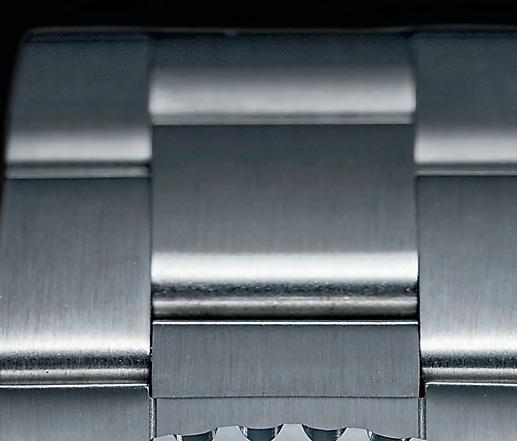

















PHILOSOPHY
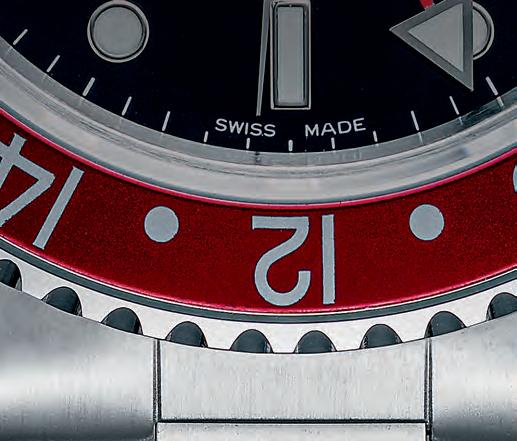


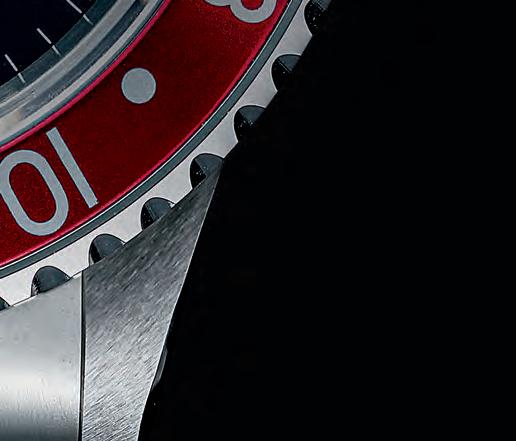





There are those who have the capacity to see beyond the present day, beyond the limitations imposed by customs, society, economy or logic. These people understand how to make observations and develop a concept – and then to transform that idea into a tangible and complete plan. They see the situation surrounding them objectively and are able to imagine the future. They offer a vision not just as a concept, but as part of the evolution of past eras as their products are continuously, inevitably surpassed. These individuals are destined to live in a time that is infinite and modern – to create objects taking part in the progress, continually renewing itself within certain aesthetic canons.
Rolex founder Hans Wilsdorf’s story falls within the canon of a 19th-century narrative. His origins are fairly mysterious: Wilsdorf was born in Kulmbach, Germany in 1881, and offi-
cial sources report that, alongside a brother and a sister, the young boy would become an orphan. This was a fate common to many youth in the late 19th century – Coco Chanel, for example, another illustrious personality who would permanently alter women’s fashion, had grown up in a convent as little Gabrielle Bonheur. Orphanhood, however, does not at all appear to have limited Hans or Gabrielle. Perhaps, in their determination to overcome life’s difficulties, they actually both found the tools that led to their successes.
What is certain is that Hans, together with his brothers, had been taken into the custody of an uncle, who took care to guarantee him a good scholastic education so he might have some job prospects. At the boarding school he attended, Wilsdorf showed a particular predilection for mathematics and languages, which would later facilitate business contacts abroad.
After the success of the advertisements linked to Mercedes Gleitze’s feat, Wilsdorf engaged various sports personalities in support of the Oyster. An ad that appeared in Punch on 18 June 1930 replicated a letter from famous racing driver Captain Malcolm Campbell, who had used a Rolex Oyster in a race: ‘Dear Sirs, I have now been using my Rolex Watch for some little while, and it is keeping perfect time under somewhat strenuous conditions. I was wearing it on the occasion of the J.C.C. Double 12 Hours Race on Friday and Saturday last, and the vibration which this watch had to with -
stand during this long period has not upset its time-keeping properties in the least. I would like to congratulate you on having produced a very first-class watch, suitable for really rough treatment. Yours faithfully, M. Campbell’.
A Rolex Oyster was on Campbell’s wrist in 1935 when the driver reached a speed over 300 miles per hour, setting the world land speed record in his race car at the Bonneville Salt Flats.
When Mount Everest was first flown over in 1933, the crew were equipped with Rolex watches, which also proved their worth in flight. Over the years, Rolex has linked its name to great feats, records and sporting events.

Two advertisements for the Oyster model. One celebrates the feat of mountaineer Hugh Ruttledge, who led Everest expeditions in 1933 and 1936. The second features a letter from British Army LieutenantColonel Stewart Blacker, who in 1933 was the first to fly over Everest. The latter’s message to Rolex following his exploit is meaningful: ‘I can hardly imagine that any watches have ever been subjected before to such extremes under practical conditions.’


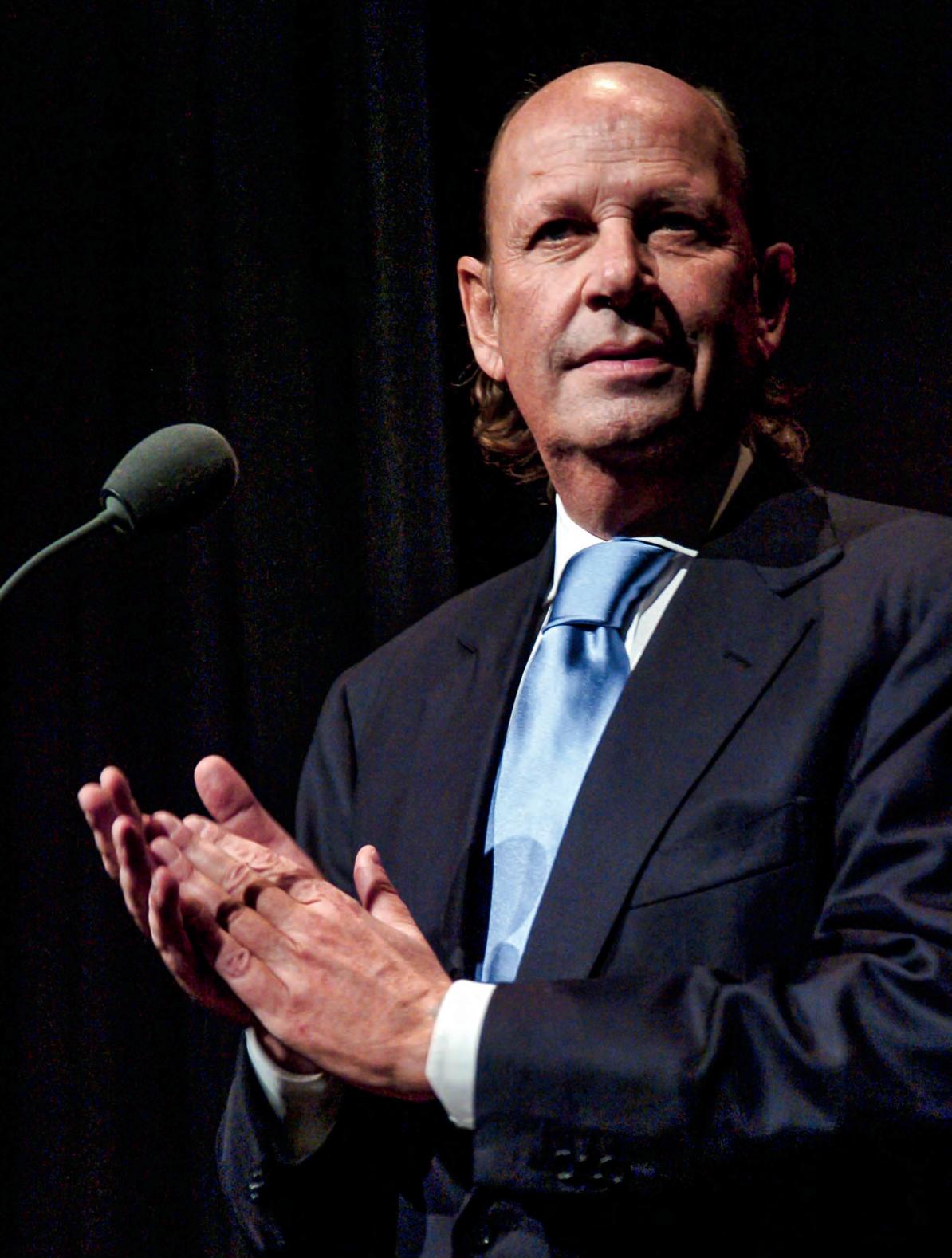
André’s son, Patrick Heiniger, became Managing Director of Rolex in 1992, having been appointed by the Rolex board to replace his father. André Heiniger assumed the position of Rolex Chief Executive Officer until his retirement in 1998, becoming Chairman Emeritus up to his death in 2000. His leadership certainly helped transform Rolex into the highly successful company it is today.
A Swiss law graduate, Patrick Heiniger was an intellectual-property attorney who set up his own law firm in New York. In 1986, he joined Rolex as its Commercial Director, then took the helm a few years later. A high-profile leader himself, he transformed Rolex into a fully vertically integrated company, acquiring suppliers from outside Rolex to bring all production in-house.
In his sixteen years of managing the company, lasting from 1992 to 2008, Rolex developed just one new model, the 1992 Yacht-Master, a luxury sports watch dedicated to the nautical universe, and especially to sailors and skippers. It also relaunched some vintage sports models: the Submariner, the GMT and the Daytona, offering them in versions with revised shapes and designs. In 2003, the green-bezelled Submariner, nicknamed Kermit, was introduced to celebrate the model’s 50-year anniversary. Again as a celebratory 50th-anniversary model, a GMT with ceramic bezel was produced in 2005. In 2007,
a new version of the Milgauss was launched at Baselworld: this model retained its antimagnetic qualities but had new features, including a 40-millimetre case, a glossy finish, and dials available in black and white.
As part of his administrative activities, the chief executive consolidated the entire Rolex business into four state-of-the-art facilities, all located in Switzerland. This resulted in extraordinary economy of scale, contributing significantly toward improving the quality of contemporary Rolex watches. During his tenure at the head of the manufacturer, Patrick Heiniger continued the development of new facilities in Geneva, culminating in 1995 with
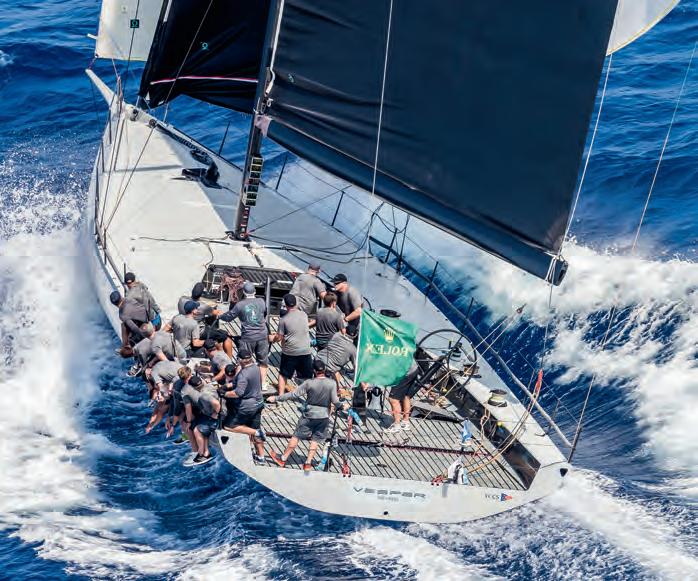


Then again, a Rolex watch is not a mere watch. Nor is it a status symbol, in the old sense of the term: whoever wears it not only sends a signal of wealth but also seeks to establish that they belong to a world, a group of people, that knows how to appreciate quality and beauty, united under a successful international image linked to prominent personalities in fields of all types.
For Hans Wilsdorf, a visionary entrepreneur, making reliable watches that lasted over time was a matter of honour. It is in this spirit that, starting from the company’s birth, Rolex’s founder began to create a network of efficient workshops dedicated to after-sales service in countries where the brand had a presence. In doing so, he guaranteed that each watch produced by the manufacturer could be given maintenance service at any time and in the manner most appropriate to maintain its extraordinary performance over time.
The company’s direction, administration and communication activities; those related to final assembly, final inspection and marketing of watches; and the Rolex World Service are all managed from the Rolex World Headquarters in Geneva. Creative as well as research and development activities are also carried out there, where the workshops are located and where all finished watches are tested before being shipped around the world. The Rolex Training Centre is also here, offering courses to company employees and managers, and trains apprentices in order to pass on its unique knowledge.
The Plan-les-Ouates site concentrates the activities involved in developing and producing Rolex watch cases and bracelets, from shaping and processing raw materials, up to the creation of finishes for the final pieces. The Chêne-Bourg site brings together activities associated with development and production of dials and bezels, as well as jewel setting. The Bienne site is entirely dedicated to the production of Rolex movements.



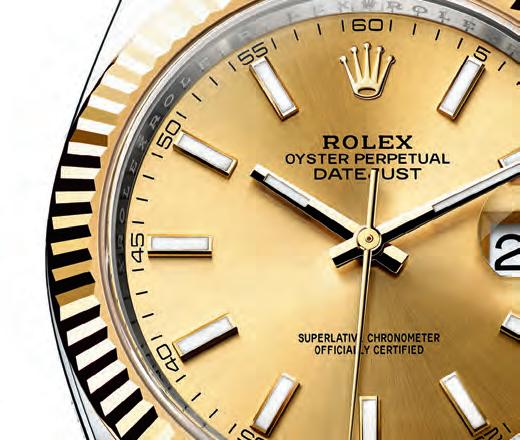
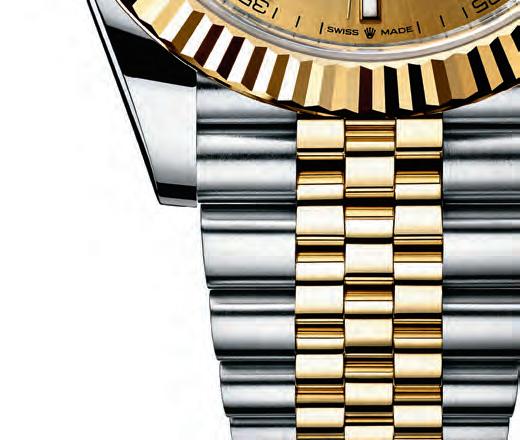





while portraying Colonel Walter Kurz in Apocalypse Now (1979) is a famous one. In the movie, the character of Kurz wears a GMT-Master without its rotatable bezel; the watch became famous, bringing in a high price at auction.
The GMT-Master has gone down in history for its unmistakable two-toned bezel. To create a more pleasant experience for crewmembers while consulting the watch, Rolex decided to adopt a bezel with two colours: red indicated daytime hours and blue nighttime.
The first version of the GMT-Master was represented by reference number 6542, whose Bakelite bezel rendered the model easily recognisable, yet extremely fragile and thus it is incredibly difficult to find in its original condition. Its two colours very soon became emblematic of the GMT-Master, even if the Geneva maison would later offer other colour pairings to choose from. The original blue-and-red bezel, affectionately known as ‘Pepsi’ among collectors, was joined by other models earning nicknames like ‘Coca-Cola’ (for its red-and-black bezel), ‘Root Beer’ (with a brown-and-gold bezel), and ‘Batman’ (which was blue and black).
In 1959, reference 6542 was replaced by reference 1675, which would remain in production up until the 1970s. The chief difference in this new version was its transition from the iconic (and problematic) Bakelite insert to a twotoned aluminium insert.
Version of the GMT model with the reference number 6542, with a Bakelite bezel.
Introduced in 1957, the Lady-Datejust is the crown watchmaker’s first timepiece entirely dedicated to women.


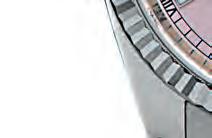
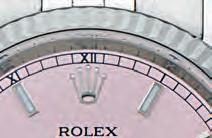





Women have played a decisive role in the history of Rolex. It was Mercedes Gleitze who swam the English Channel in 1927 wearing a Rolex Oyster, providing Rolex with their first endorsement. She indeed birthed the very concept of a Testimonee.
In the 1950s, as well-being spread among all social classes and significant engineering and industrial discoveries profoundly altered everyday life, the figure of the woman also changed,
taking on a more independent role in society. In 1957, Audrey Hepburn fascinated Hollywood with her delicate elegance; Sylvia Earle obtained her Master of Science degree to later become a famous oceanographer (and the first woman to head the United States’ National Oceanic and Atmospheric Administration); and Françoise Sagan, at a time when the French word for ‘writer’ rarely appeared in feminine form, conquered the world literary scene with her novel Bonjour Tristesse .
Hans Wilsdorf, ever attentive to lifestyle, understood that the modern woman sought to manage her time and therefore needed the same precision that men did. Women’s watches had, to that point, been objects where aesthetics prevailed and the precision of their mechanics was secondary. A watch of small proportions posed an important engineering challenge: that of creating a mechanical movement that was relatively small, yet capable of ensuring the same high chronometric standards of the larger counterparts installed in men’s watches. As Wilsdorf himself testifies: ‘Ladies want the best of both worlds: a tiny watch and an accurate movement. Yet, the smaller the watch, the more difficult it is to make it accurate.’
In 1957, Rolex introduced the Lady-Datejust, succeeding in the feat of creating an extraordinarily precise, robust watch, one worn by generations of successful women around the world. The ladies’ Datejust featured all characteristics that had been introduced in the Datejust of 1945. The first edition of the women’s chronometer with a calendar, it continued to carry the elegance of the Datejust in a smaller format, perfectly suited to slim wrists. The watch was initially produced with a 26-millimetre diameter, a size that seamlessly followed the trends of the time and was kept for decades. In 2015, the maison launched the 28-millimetre Lady-Datejust.
Thanks to its iconic robust and durable Oyster case, the Lady-Datejust is water resistant to a depth of 100 metres and has a highly sophisticated mechanical movement, developed and manufactured entirely by Rolex to its Superla-
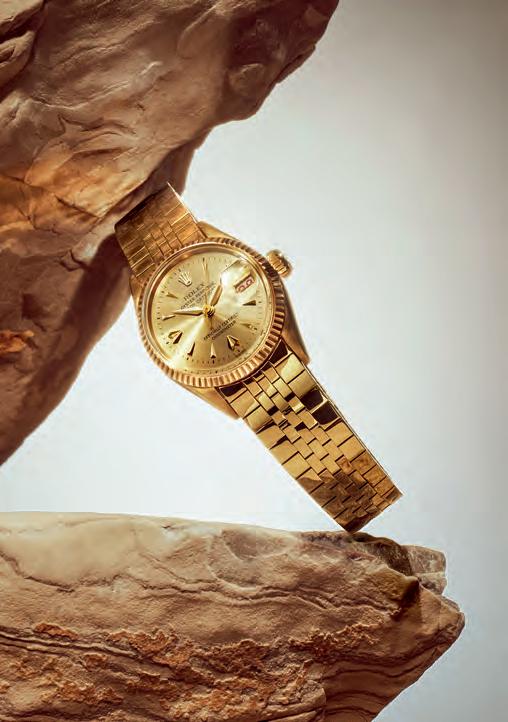
tive Chronometer standards. With its instantaneous date, Perpetual self-winding system, silicon hairspring, Paraflex anti-shock system, and 55 hours of power reserve, the Lady-Datejust is perfectly equipped to perform its tasks with the utmost diligence at any time, in any context. Its middle case is crafted from a solid block of Oystersteel, an alloy that is especially resistant to corrosion, or of gold. The finely fluted case back is hermetically screwed down using a special tool which allows only Rolex-approved watchmakers to gain access to its movement.
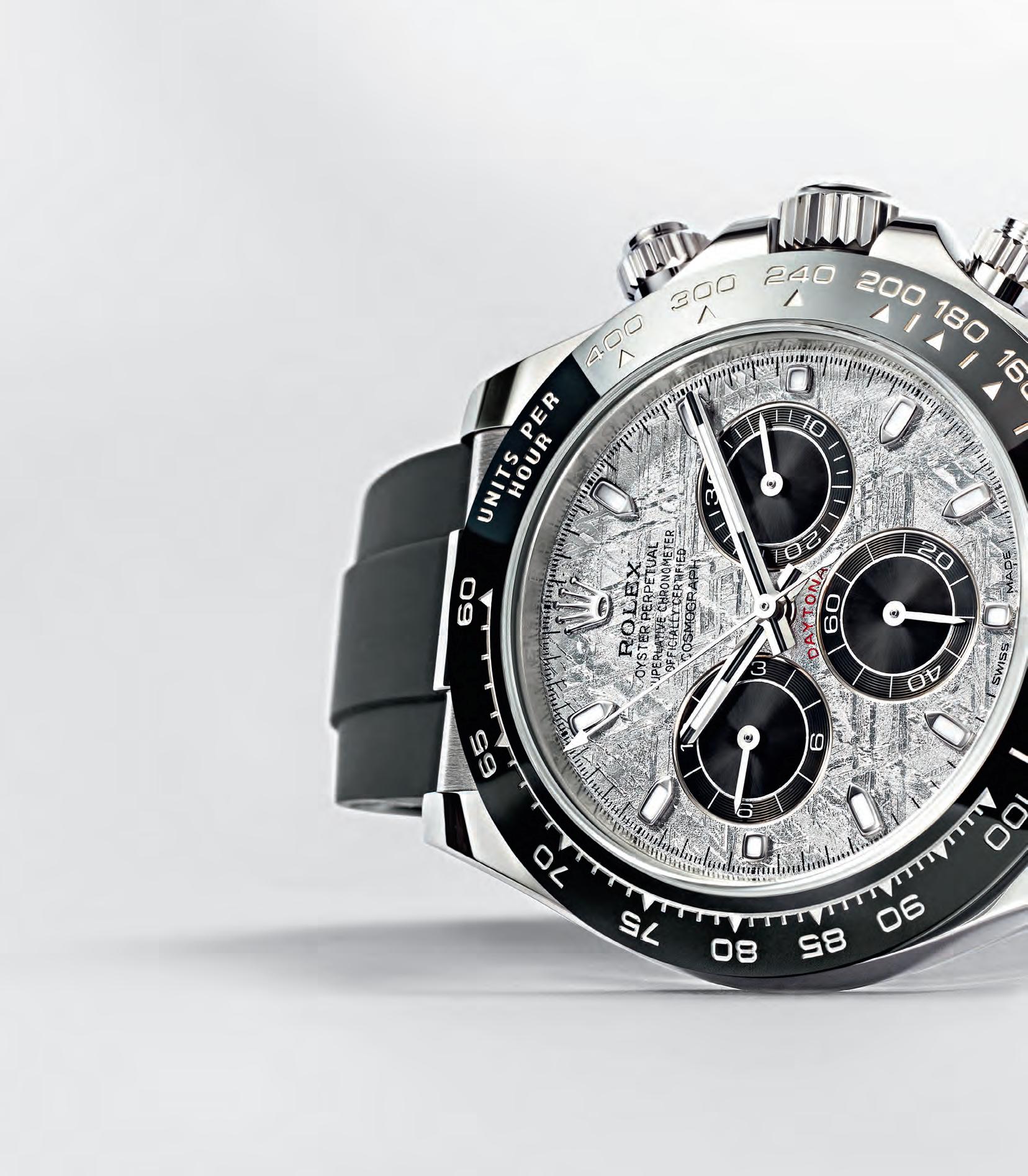

The Oyster Perpetual Yacht-Master embodies the close ties connecting Rolex and the world of sailing since the 1950s.

Thanks to their water resistance and chronometric precision, over time Oyster watches have become valued tools for sailing. In 1967, Sir Francis Chichester was the first yachtsman to complete a solo voyage around the globe. He received a hero’s welcome upon his return and was knighted by the Queen of England. In a letter from 1968, he wrote: ‘During my voyage around the world in Gipsy Moth IV, my Rolex watch was knocked off my wrist several times without being dam -
aged. I cannot imagine a hardier timepiece. When using [it] for sextant work and working the foredeck, it was frequently banged, also doused by waves coming aboard; but it never seemed to mind all this.’
Based on these experiences, Rolex developed a model that was suited to travel with sailors.
Presented in 1992, the Yacht-Master was intentionally designed for sailors and skippers. The watch was instantly recognisable
for its bidirectional rotatable bezel with raised 60-minute graduation, produced entirely in precious metals (gold or platinum) or fitted with a high-tech Cerachrom ceramic insert. The polished graduation and numerals stand out against their matt background. The characteristic functional bezel allows the wearer to calculate an interval of time – how long it takes to cover the distance between two buoys, for example – fully contributing to the timepiece’s unique identity. Thanks to its knurled edge, providing excellent grip, the bezel can be controlled easily.
The Yacht-Master guarantees optimal legibility in every circumstance, including the dark, thanks to its unique Chromalight display: the large indices and broad hands are respectively filled and coated with a long-lasting luminescent material (in the colour blue), which glows up to two times longer than classic phosphorescent materials.
The Yacht-Master’s Oyster case, either 37, 40 or 42 millimetres in diameter, is guaranteed waterproof to a depth of 100 metres. The Triplock winding crown, with a triple waterproofing system and protected by an integral crown guard, screws down firmly against the case. The crystal, with a Cyclops lens above 3 o’clock for easier reading of the date, is in scratch-resistant sapphire and benefits from an antireflective coating. Yacht-Master models are equipped with the calibre 2236 (Yacht-Master 37) or calibre 3235 (Yacht-Masters 40 and 42) self-winding mechanical movements entirely developed and produced by Rolex.
The oscillator in calibres 2236 and 3235 has

The Yacht-Master model with a bidirectional rotatable bezel with raised 60-minute graduation, made entirely of gold.
a balance wheel with variable inertia, calibrated with extreme precision by Microstella nuts. It is securely held in place by a height-adjustable traversing bridge for extremely stable positioning and better shock resistance. The oscillator is additionally fitted on high-performance Rolex-developed and -patented Paraflex shock absorbers. Calibre 2236 is equipped with a Syloxi silicon hairspring, also patented and produced by the brand, while calibre


contains a blue Parachrom hairspring, made by Rolex in a paramagnetic alloy, which, while also being insensitive to magnetic fields, boasts high stability with fluctuations in temperature. It is equipped with a Rolex overcoil, which ensures regular running of the movement at every position. Calibre 4161 features an automatic winding module with Perpetual rotor, which ensures continuous winding of the mainspring and thus supplies constant energy using the movements of the wrist. It boasts a power reserve of approximately seventy-two hours. The Yacht-Master II, like every Rolex watch, boasts a Superlative Chronometer certification.
DIAL: Yacht-Master II’s design is characterised by its white-and-blue dial with blue bezel. This model features a prominent circular arc with numbers arranged clockwise from 10 to 0, along which a small hand with a triangular tip travels. The bezel features the same sequence of numbers, complete with the inscription ‘Yacht-Master II’. Its decreasing numerals make it immediately clear that timing is not accomplished by adding the times but, rather, like a countdown. In addition to its central seconds, minutes and hours hands, it has small seconds at 6 o’clock.
CASE: The Yacht-Master II, fitted with a 44-millimetre-diameter Oyster case, features the Ring Command system, an interaction mechanism between the case and the movement, which allows the wearer to adjust the duration of the countdown by means of its rotatable bezel and winding crown.
BRACELET: The Yacht-Master II is paired with a three-piece-link Oyster bracelet. This bracelet features an Oysterlock safety clasp, which prevents any inadvertent opening. It also features the Easylink comfort extension link, developed by the brand, which allows the wearer to easily increase its length by about 5 millimetres for additional comfort in any circumstance.











Some timepieces that were produced in small numbers and over limited periods are now assiduously sought by collectors.
In the early 1900s, when men were beginning to wear wristwatches rather than placing them in their pockets, it was immediately clear that the new timepieces would have a much ‘harder’ life. Pocket watches, protected inside one’s clothing, were spared exposure to rain and humidity, as well as dust and shocks. These were elements that inevitably became part of the active lifestyle that was growing more popular in those years.
The introduction of a waterproof watch case and self-winding movement from Rolex, taking place over the 1920s and the beginning of the 1930s, certainly changed the history of watchmaking forever, setting the standard for timepieces of the modern era. If many of the models still being produced by Rolex today date from these early prototypes and are widely known on the market, others belonging to the ‘crown’ maison ’s history were produced in small quantities, in limited or personalised
editions. Today, these are highly valued on the collector’s market.
Among these examples of rare technical features and design, for example, is the first Oyster from 1926, with an octagonal design in homage to the Art Deco style that was in vogue in Europe. Just a few years later, in 1931, the first Oyster Perpetual had a much more streamlined slight tonneau shape; it soon assumed the form which would then remain nearly unchanged until today.
Also following the Art Deco style, the Prince model was a watch in rectangular format with a dual dial; it was also dubbed the ‘Doctor’s Watch’ for its separation of the hours and seconds dials, allowing the doctor to more easily read a heartbeat and pulse. Unlike the Oyster, it had no waterproof case, but its movement allowed for a higher degree of precision. The first Rolex Prince models were the Prince Classic and Prince Brancard: the Vintage Rolex Prince ad declaring: ‘The watch for men of distinction.’
In 2002, when the original owner’s family auctioned it, again with Phillips, it sold for $235,000; but fifteen years later it would fetch 5 million francs, far exceeding the initial estimate of more than 1.5 million.
Among the many record-breaking Rolexes is a GMT-Master worn by Marlon Brando on the set of the movie Apocalypse Now in 1979. While filming in the Philippines, a member of the production staff advised Brando not to wear the easily recognised Rolex in order to make his character more believable, since he was playing an army colonel lost in the jungle. Brando then decided to have the overly conspicuous rotating bezel removed, leaving the shiny metal beneath. This peculiarity, and its case back engraved with ‘M. Brando’ by the actor himself using a special electric engraving pen, made this object unique – so unique that it reached the figure of $1.9 million in 2019. Another record-breaking example was the white-gold Daytona dubbed the ‘Unicorn’, created in 1970 on a special order from a major German retailer, which fetched 5.93 million Swiss francs. In 2019, a specimen of the reference 4113 split-second chronograph fetched 2.4 million francs. It was the first and only split-second watch Rolex ever produced, rare and unobtainable.
The reference 6062 triple-calendar moon-phase watch made for the Vietnamese emperor, for whom it was named ‘Bao Dai’. This specimen is enhanced by a black dial with five diamond indices, present in only three other examples of the 6062. The diamonds’ arrangement, however, differs from that of the other three watches, making this timepiece unique in all respects. The black dial with a lacquer finish, paired with the diamonds, lends the watch an unparalleled charm, all of it housed in a 36mm yellow-gold Oyster case.

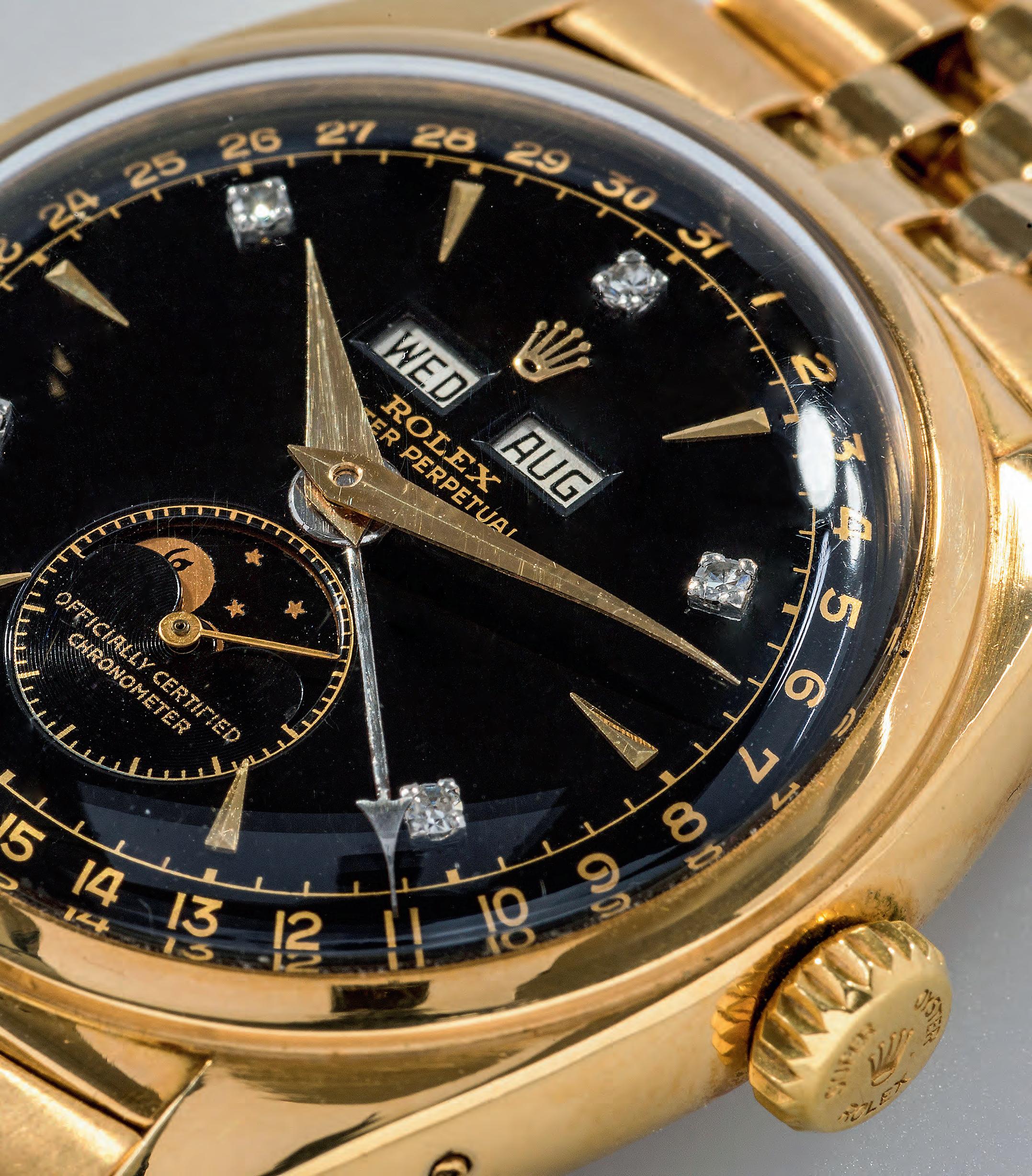
Rolex is a worldwide phenomenon. This rich photobook uses images, direct testimonials, interviews, archive materials and advertising to recount the path from the inception of this worldfamous watch brand to the present day.
Follow the evolutionary path of the innovative techniques and extraordinary designs that made Rolex the powerhouse it is today. Discover the true and unique, inimitable Rolex philosophy – the identity at the heart of a century-long success.
Written by author and jewellery expert Mara Cappelletti, Rolex
Philosophy is a meticulously illustrated journey through all things Rolex. With technical details, auction results, and background insights, this is a must-have for all collectors and enthusiasts.
ISBN: 978-1-78884-239-6